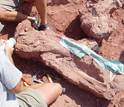News Release 17-081
Paleontologists discover new species of sauropod dinosaur in Tanzania
Fossil remains recovered from 70 to 100 million-year-old rocks in southwestern Tanzania

Reconstruction of the new titanosaur and the landscape in which it lived, in what is now Tanzania.
August 24, 2017
This material is available primarily for archival purposes. Telephone numbers or other contact information may be out of date; please see current contact information at media contacts.
Paleontologists have identified a new species of titanosaurian dinosaur. The research is reported in a paper published this week in the Journal of Vertebrate Paleontology and is funded by the National Science Foundation (NSF).
The new species is a member of the gigantic, long-necked sauropods. Its fossil remains were recovered from Cretaceous Period (70-100 million years ago) rocks in southwestern Tanzania.
Titanosaur skeletons have been found worldwide, but are best known from South America. Fossils in this group are rare in Africa.
The new dinosaur is called Shingopana songwensis, derived from the Swahili term "shingopana" for "wide neck"; the fossils were discovered in the Songwe region of the Great Rift Valley in southwestern Tanzania.
Part of the Shingopana skeleton was excavated in 2002 by scientists affiliated with the Rukwa Rift Basin Project, an international effort led by Ohio University Heritage College of Osteopathic Medicine researchers Patrick O'Connor and Nancy Stevens.
Additional portions of the skeleton -- including neck vertebrae, ribs, a humerus and part of the lower jaw -- were later recovered.
"There are anatomical features present only in Shingopana and in several South American titanosaurs, but not in other African titanosaurs," said lead paper author Eric Gorscak, a paleontologist at the Field Museum of Natural History in Chicago. "Shingopana had siblings in South America, whereas other African titanosaurs were only distant cousins."
The team conducted phylogenetic analyses to understand the evolutionary relationships of these and other titanosaurs.
They found that Shingopana was more closely related to titanosaurs of South America than to any of the other species currently known from Africa or elsewhere.
"This discovery suggests that the fauna of northern and southern Africa were very different in the Cretaceous Period," said Judy Skog, a program director in NSF's Division of Earth Sciences, which supported the research. "At that time, southern Africa dinosaurs were more closely related to those in South America, and were more widespread than we knew."
Shingopana roamed the Cretaceous landscape alongside Rukwatitan bisepultus, another titanosaur the team described and named in 2014.
"We're still only scratching the surface of understanding the diversity of organisms, and the environments in which they lived, on the African continent during the Late Cretaceous," said O'Connor.
During the tectonically active Cretaceous Period, southern Africa lost Madagascar and Antarctica as they split off to the east and south, followed by the gradual northward "unzipping" of South America.
Northern Africa maintained a land connection with South America, but southern Africa slowly became more isolated until the continents completely separated 95-105 million years ago. Other factors such as terrain and climate may have further isolated southern Africa.
Paper co-author Eric Roberts of James Cook University in Australia studied the paleo-environmental context of the new discovery.
The bones of Shingopana, he found, were damaged by the borings of ancient insects shortly after death.
Roberts said that "the presence of bone-borings provides a CSI-like opportunity to study the skeleton and reconstruct the timing of death and burial, and offers rare evidence of ancient insects and complex food webs during the age of the dinosaurs."
The study was also funded by the National Geographic Society, Jurassic Foundation, Paleontological Society, Ohio University Student Enhancement Award, Ohio University Original Work Grant, Ohio University Heritage College of Osteopathic Medicine, Ohio University Office of the Vice President for Research and Creative Activity, and James Cook University.
-NSF-
-
Wide shot of the southwestern Tanzania locality from which the new dinosaur was excavated.
Credit and Larger Version -
The research team at the quarry site in which the dinosaur skeleton was found.
Credit and Larger Version -
Excavation of Shingopana songwensis showing bones being prepared for plaster-jacketing.
Credit and Larger Version -
View of the scientists' field camp in the Rukwa Rift Basin in southwestern Tanzania.
Credit and Larger Version -
A typical view, the researchers say, of sunset over the Rukwa Rift Basin.
Credit and Larger Version
Media Contacts
Cheryl Dybas, NSF, (703) 292-7734, email: cdybas@nsf.gov
Jim Phillips, Ohio University, (740) 593-2202, email: phillij2@ohio.edu
The U.S. National Science Foundation propels the nation forward by advancing fundamental research in all fields of science and engineering. NSF supports research and people by providing facilities, instruments and funding to support their ingenuity and sustain the U.S. as a global leader in research and innovation. With a fiscal year 2023 budget of $9.5 billion, NSF funds reach all 50 states through grants to nearly 2,000 colleges, universities and institutions. Each year, NSF receives more than 40,000 competitive proposals and makes about 11,000 new awards. Those awards include support for cooperative research with industry, Arctic and Antarctic research and operations, and U.S. participation in international scientific efforts.
Connect with us online
NSF website: nsf.gov
NSF News: nsf.gov/news
For News Media: nsf.gov/news/newsroom
Statistics: nsf.gov/statistics/
Awards database: nsf.gov/awardsearch/
Follow us on social
Twitter: twitter.com/NSF
Facebook: facebook.com/US.NSF
Instagram: instagram.com/nsfgov





